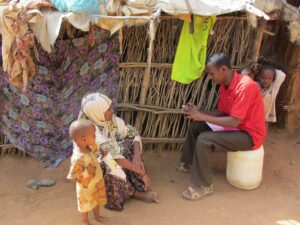Introduction
In the realm of development projects and organizational strategies, Monitoring and Evaluation (M&E) play a pivotal role in ensuring efficacy, sustainability, and accountability. Understanding the Cost of Monitoring and Evaluation Consultancy in Uganda is crucial for stakeholders aiming to optimize their project outcomes and resource utilization.
Overview of Monitoring and Evaluation Consultancy Services in Uganda
M&E consulting services in Uganda include a wide range of expert-driven tasks meant to evaluate project performance, gauge impact, and improve decision-making procedures. These services play a critical role in directing initiatives in a number of sectors, including infrastructure, economic development, healthcare, and education.
Importance of Monitoring and Evaluation (M&E) in Project Success
In addition to assessing the success and impact of projects, good M&E procedures give stakeholders useful information that they can use to improve plans and distribute resources more effectively. Through methodical data collection and analysis, Monitoring and Evaluation (M&E) guarantees that initiatives stay on course, accomplish goals, and provide significant results for recipients and communities.
Budgeting for Monitoring and Evaluation
When planning your project in Uganda, understanding the Cost of Monitoring and Evaluation Consultancy in Uganda is crucial for effective budgeting. Here’s how to get it right:
How much budget should be allocated for M&E?
Determining the exact budget for Monitoring and Evaluation (M&E) in Uganda depends on various factors such as project scope, duration, and complexity. Typically, experts suggest allocating between 5% to 10% of your total project budget to M&E activities. This ensures sufficient resources for data collection, analysis, and reporting, crucial for measuring project impact and success.
What percentage of a program’s budget should go towards M&E?
A generally recommended guideline is allocating around 5% to 7% of your program’s total budget towards M&E. This range strikes a balance between ensuring rigorous evaluation of project outcomes while not overly burdening the overall project costs. However, this percentage can vary based on specific project goals and donor requirements.
Understanding normal and ideal budget allocations
In Uganda, normal budget allocations for M&E typically align with international standards, where organizations prioritize around 5% to 10% of project budgets for effective evaluation. Ideally, the budget should cover expenses for skilled consultants, data collection tools, technology, and reporting mechanisms tailored to the local context.
Effective budgeting for Cost of Monitoring and Evaluation Consultancy in Uganda involves strategic planning and flexibility to adjust based on project needs and outcomes. By allocating resources wisely, organizations can enhance project accountability, transparency, and ultimately achieve greater impact in their development initiatives.
Setting and Monitoring Budgets
When it comes to managing the Cost of Monitoring and Evaluation Consultancy in Uganda, effective budgeting is key. Here’s how you can ensure your M&E budget stays on track:
Strategies for setting effective M&E budgets
- Set Important Activities in Order of Priority: Determine the essential M&E tasks that support the goals of your project. Make appropriate financial allocations to guarantee that these initiatives receive adequate support for the course of the project.
- Speak with Experts: During the planning stage, consult M&E professionals. Their knowledge can aid in precise cost estimation and budget allocation recommendations based on project complexity and industry standards.
- Take Local Context Into Account: When establishing budgets, take into account the unique operational and economic circumstances of Uganda. This guarantees practical financial planning that takes local labor costs, inflation rates, and resource availability into consideration.
Techniques for monitoring M&E budgets throughout a project
- Regular Reviews: Schedule regular budget reviews to track expenditure against planned allocations. This proactive approach allows for timely adjustments and ensures financial resources are used efficiently.
- Use of Technology: Utilize M&E software and tools to streamline budget monitoring. These tools offer real-time insights into spending patterns, helping you identify potential overruns or underspending early on.
- Stakeholder Engagement: Keep stakeholders informed about budgetary progress. Transparent communication fosters accountability and encourages collaboration in managing financial resources effectively.
By implementing these strategies and techniques, organizations can effectively manage the Cost of Monitoring and Evaluation Consultancy in Uganda. This proactive approach not only enhances project efficiency but also supports accurate reporting and decision-making throughout the project lifecycle.
Activities of Monitoring and Evaluation
In Uganda, monitoring and evaluation (M&E) consulting entails vital tasks that guarantee projects remain on course and successfully accomplish their objectives.
Key activities involved in M&E processes:
- Data Collection: Compiling pertinent information via surveys, interviews, and observation in order to evaluate the status of the project.
- Indicator Development: Specifying quantifiable markers to monitor the effectiveness and influence of a project.
- Impact Assessment: Assessing how project interventions have affected communities and stakeholders more broadly as well as the results.
- Reporting and Analysis: Gathering information and creating in-depth reports, as well as evaluating data to pinpoint areas that need work.
Examples of M&E activities in Uganda:
- Healthcare Projects: Keeping an eye on the execution of health programs to enhance access to medical treatment in various geographic areas.
- Education Programs: Evaluating educational interventions to enhance literacy rates and school attendance in underserved communities.
- Agricultural Development: Assessing the impact of agricultural projects on local farmers’ livelihoods and food security.
- Infrastructure Projects: Monitoring the construction and maintenance of roads, bridges, and utilities to ensure quality and sustainability.
These activities illustrate how M&E consultancy plays a pivotal role in assessing project effectiveness and guiding future decision-making in Uganda’s development landscape.
Budget Rules and Guidelines
When it comes to the Cost of Monitoring and Evaluation Consultancy in Uganda, understanding the ideal budget rules is crucial for effective project management and evaluation. Here’s what you need to know:
The Ideal Budget Rule for M&E in Development Projects
Allocating funds for Monitoring and Evaluation (M&E) should typically range between 5% to 10% of the total project budget. This range ensures adequate resources are dedicated to assessing project performance, improving outcomes, and ensuring accountability. In Uganda, this allocation is key to enhancing program effectiveness and demonstrating impact.
Allocating Funds for Project Management: What Percentage is Appropriate?
For project management, allocating around 10% to 15% of the budget is commonly recommended. This covers the costs associated with overseeing project activities, coordinating stakeholders, and ensuring milestones are met on time and within budget. By setting aside the right proportion for project management, organizations in Uganda can streamline operations and maximize project success.
Understanding these budget guidelines is essential for organizations aiming to optimize their investments in Monitoring and Evaluation consultancy within Uganda’s development landscape.
Project Management Fees
When it comes to the cost of Monitoring and Evaluation Consultancy in Uganda, understanding project management fees is crucial. Project management fees typically vary based on the scope and complexity of the project, as well as the experience of the project manager.
Recognizing Typical Project Management Charges
In Uganda, typical project management costs might vary based on a number of variables, such as the project’s duration, the specialized knowledge needed, and organizational overheads. Project management fees typically represent a portion of the overall project budget, typically falling within the range of 5% to 15%.
How to Precisely Determine Project Management Fees
Accurately calculating project management fees requires taking a number of factors into account. Establish the project’s parameters and the precise duties that the project manager will perform first. Next, calculate how long the project will take in total and how many hours the project manager will spend supervising and arranging tasks.
Once these factors are clear, calculate the project management fee by multiplying the estimated hours by the project manager’s hourly rate or by applying a percentage to the total project budget. It’s essential to account for any additional costs such as travel, materials, or specialized software that the project manager may require.
By understanding these aspects, organizations can budget effectively for project management services within their Monitoring and Evaluation Consultancy initiatives in Uganda.
Conclusion
When it comes to the Cost of Monitoring and Evaluation Consultancy in Uganda, strategic budget planning plays a pivotal role in ensuring project success. Allocating the right resources to M&E consultancy is crucial for evaluating program impact and effectiveness. By understanding how much should be budgeted and what percentage of funds should go towards M&E activities, organizations in Uganda can optimize their investments and achieve meaningful outcomes. Effective monitoring and evaluation not only enhances accountability but also enables continuous improvement and learning within development projects. Therefore, choosing the right consultancy services and planning budgets meticulously are essential steps toward maximizing the impact of development initiatives across Uganda.






